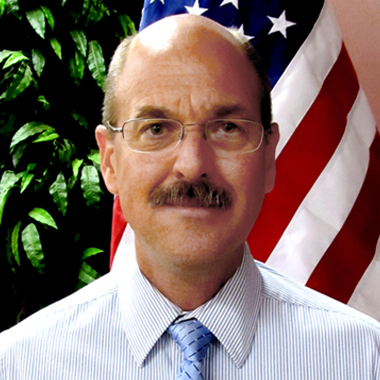
To 30 parts Top Gun, add a smattering of Sonny and Crocket, professionally coat with city management and out of the “Danger Zone” flies Dick Eason, former town administrator, Elizabeth, Colorado. Dick’s itinerary toward city management veered from the traditional intern-assistant to assistant manager-manager career path traveled by many local government professionals.
After launching his cap at graduation from the United States Naval Academy, Dick took to the skies at Navy Flight School and earned his aviator wings in 1986. His piloting career culminated with 10 tours of duty, including missions in the Persian Gulf and combatting drug running in Central and South America. He also oversaw operations for all of the Navy’s bases and facilities in the Middle East and Africa, “essentially managing 6 small cities.” Dick somehow found time between liftoffs to earn a master's of arts in national security and strategic planning and a master's of science in business administration from Strayer University in 2000.
Twenty years of Navy flying did not ground Dick from his service to the Navy. He accepted the command center directorship for the North American Aerospace Defense Command (NORAD) and U.S. Northern Command (USNORTHCOM) in 2006 and spent four years in that role. Captain Richard Eason retired from the Navy in late 2010. Excelling at managing the Navy bases in the Middle East and Africa, Dick decided to apply his military experience to local government seeing a “direct translation of skill set and responsibilities” between the two experiences. Dick chartered a course towards city management, and touch-downed in Elizabeth, Colorado, as its town administrator in 2013.
From Mess Hall to City Hall
The town of Elizabeth, approximately 40 miles southeast of Denver, is to the metropolitan lifestyle of the state capital and the rural flair of Colorado, as is the Gateway Arch to the West and the East. Founded 125 years ago, Elizabeth grew up as a lumber town (after a short-lived gold rush) that then brought the transportation of the railroad. Unfortunately, a flood in 1935 warped and rusted the two industries. The social landscape of the town changed into an “artistic community and supported the area ranches” as Dick described. Despite its bygone lumber roots, Elizabeth’s 1,500 residents still proudly display their green thumbs and enjoy exploring the frontier.
Residents recycled the Elizabeth’s old tree farm to create a community garden where they can grow their own fresh produce. This spring, residents will begin to sow seeds in their plots and next summer’s farmers’ market will be flush with Elizabeth-grown peppers, tomatoes, and cucumbers. Resident farmers will gather at the garden to cajole their harvests and devise plans on how to trick their kids into eating the bounty.
A proposed 5-mile trail system will breathe a breath of fresh mile-high air into Elizabeth’s healthy lifestyle. Although the trail system is in its early development stages, Dick foresees that the trails will “provide bikers, hikers, runners as well as equestrian riders opportunities for healthy recreation. Additionally, this project will connect community centers, schools, parks, and county open spaces.”
Money Is Also Green
Managing and living in a small town such as Elizabeth does not insulate it from the revenue-services paradigm. Dick echoed the sentiment that many of his colleagues declare every year (quite loudly, usually around budget season) – “how to provide the best municipal services to the residents for the least cost. The challenge is understanding the needs of the residents, and finding the most cost-effective ways to meet those needs without putting financial strain on the residents.” Dick noted a slippery slope in that Elizabeth’s water and sewer rates have remained constant over the last decade despite ever-rising costs for production and treatment.
Learning Something New
Trading a flight suit for one with pinstripes comes with a sharp learning curve but Dick does not let that deter him from continually learning. Dick credits learning from the military on being adaptable and how to acquire new skills quickly for his success in local government management. He expanded, “When you spend 30 years being transferred to a new position every two to three years, often one where you start with little to no experience in that specific field, you learn to figure out what is important in order to get up to speed quickly. You also learn to find the experts on any particular issue and ask the right questions to get the information needed to make a decision, which is critical when your expertise is a mile wide, but only an inch deep in most areas. Even with about two years under his belt as a city manager, Dick has utilized many of the online and print resources disseminated by ICMA. Additionally, over the last three years, Dick has “actively engaged” in the Emerging Managers Program offered by the Colorado City and County Management Association “in part to gain knowledge of local government from those that have been in the career longer than I, and in part to share leadership experiences that I gained through my 30 years of military service.”
NOTE: Some information about Mr. Eason’s military career courtesy of the article titled “Charting New Ground” written by Courtney MacGregor Coder, Senior Editor of Scholar, the alumni journal of Strayer University. The article appeared in the Fall 2010 edition (Volume 13, Number 3, pages 7 – 8).
New, Reduced Membership Dues
A new, reduced dues rate is available for CAOs/ACAOs, along with additional discounts for those in smaller communities, has been implemented. Learn more and be sure to join or renew today!
